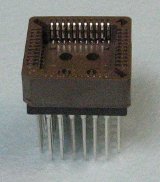GARTHWILSON wrote:
Ok, I took a picture of one of mine, a 44-pin, from Aries (although they no longer supply it):

It's no bigger than a standard thru-hole one.
[
Edit, 1/21/13: BigEd just pointed us to a source that stocks them:
http://uk.rs-online.com/web/c/?searchTe ... ra=oss&r=t ]
I'm pretty sure the Aries device in Garth's photo is just a rather specialized wire-wrap socket mated to an ordinary, solder-tail PLCC socket and sold as a single product. It looks pretty good.

But in case the price & availability don't suit you there are alternatives. Here again (below) is an ordinary, solder-tail PLCC socket, plus some plate-through PCB proto-board and two different styles of pins.
Attachment:
 wire-wrap PLCC materials.JPG [ 76.55 KiB | Viewed 49076 times ]
wire-wrap PLCC materials.JPG [ 76.55 KiB | Viewed 49076 times ]
"Plan A" (below) is to use machined socket pins similar to those in the Aries product. These ones are 0038-3-17-15-30-27-02-0 from Mill-Max Manufacturing. They're a bit pricey but cheaper overall, I expect, than an Aries socket, especially if you buy the Mill-Max in quantity. You may want to stock up anyway, given that the same pins can mate with a lot of different stuff (including various sizes of PLCC sockets).
Attachment:
 wire-wrap PLCC with machined pins.JPG [ 32.92 KiB | Viewed 49076 times ]
wire-wrap PLCC with machined pins.JPG [ 32.92 KiB | Viewed 49076 times ]
"Plan B" (below) is to use plain pins, carefully wedged into the same holes occupied by the solder-tail pins of the PLCC socket. It's tight, but you should be OK as long as you pay attention to the rectangular cross-section of the solder-tails. The final step is soldering, but for the photo session I didn't do that.
Attachment:
 wire-wrap PLCC with plain pins (bottom).JPG [ 66.94 KiB | Viewed 49076 times ]
wire-wrap PLCC with plain pins (bottom).JPG [ 66.94 KiB | Viewed 49076 times ]
I have yet to use these ideas on a real project but they look fairly workable as long as you take your time and use a fine-tip soldering iron. In particular, you'll want to plan the sequence so the inner rows' pins get installed and soldered before they're blocked by the outer rows. Also plan your connections to Gnd, Vcc and especially the bypass caps.
Be sure to use proto-board whose holes are plated through, as they offer better solder adhesion and thus more mechanical support. You don't want any pins twisting off during the wrap process. That could be tricky to fix if the neighboring pins are already wrapped and the region is congested with wire.

Attachment:
 wire-wrap PLCC with plain pins (top).JPG [ 56.01 KiB | Viewed 49076 times ]
wire-wrap PLCC with plain pins (top).JPG [ 56.01 KiB | Viewed 49076 times ]
Finally, here's a top view of Plan B -- but what I want to draw attention to is the power plane surrounding the plate-through holes. Because there's no solder mask, the entire surface is susceptible to accidental shorts. All it takes is an errant shard of wire-warp wire or a tiny spatter of solder.
If your luck is bad, such a particle could lodge itself invisibly underneath the PLCC socket or some other component, and it would be impossible to detect and fix. I'm not a worrier by nature but I am uncomfortable with a power plane on the top (component side). The board in the photos is from Twin Industries, and they offer a double-sided power plane version as well. But I'll settle for a ground plane on the wiring side (bottom) only, where gravity isn't attracting debris, and where you have a better chance of seeing & correcting any trouble.
cheers,
Jeff
_________________
In 1988 my 65C02 got six new registers and 44 new full-speed instructions!
https://laughtonelectronics.com/Arcana/ ... mmary.html






